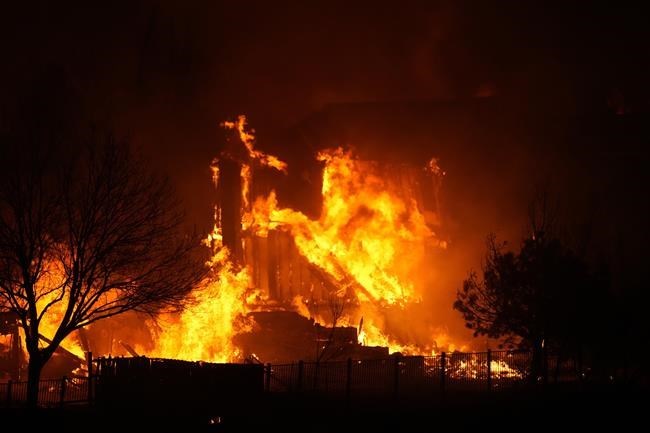DENVER (AP) ŌĆö An estimated 580 homes, a hotel and a shopping center have burned and tens of thousands of people were evacuated in wind-fueled wildfires outside Denver, officials said Thursday evening.
At least one first responder and six others were injured, though Boulder County Sheriff Joe Pelle acknowledged there could be more injuries and deaths could be possible due to the intensity of fires that quickly swept across the region as winds gusted up to 105 mph (169 kph).
The first fire erupted just before 10:30 a.m. and was ŌĆ£attacked pretty quickly and laid down later in the day and is currently being monitoredŌĆØ with no structures lost, Pelle said.
A second wildfire, reported just after 11 a.m., ŌĆ£ballooned and spread rapidly east,ŌĆØ Pelle said. The blaze spans 2.5 square miles (6.5 square kilometers) and has engulfed parts of the area in smoky, orangish skies and sent residents scrambling to get to safety.
The activity of the fires, which are burning unusually late into the winter season, will depend on how the winds behave overnight and could determine when crews are able to go in and begin assessing the damage and searching for any victims.
ŌĆ£This is the kind of fire we canŌĆÖt fight head on,ŌĆØ Pelle said. ŌĆ£We actually had deputy sheriffs and firefighters in areas that had to pull out because they just got overrun,ŌĆØ he added.
Evacuations have been ordered for the city of Louisville, home to about 21,000 people, and Superior, which has another 13,000 residents.
The neighboring towns are roughly 20 miles (32 kilometers) northwest of Denver in an area filled with middle and upper-middle class subdivisions surrounded by shopping centers, parks and schools. The area is in between Denver and Boulder, a foothills college town home to the University of Colorado.
Residents evacuated fairly calmly and orderly, but the winding streets in the suburban subdivisions quickly became clogged as people tried to get out. It sometimes took cars as long as 45 minutes to advance about a half mile (less than a kilometer).
Small fires cropped up here and there in surprising places ŌĆö on the grass in a median or in a dumpster in the middle of a parking lot ŌĆö as wind gusts caused the fire to jump and spread. Shifting winds caused the skies to turn from clear to smoky and then back again as emergency sirens blared nearby.
Some of the several blazes in the area Thursday were sparked by downed power lines.
Six people who were injured in the fires were being treated at UCHealth Broomfield Hospital, spokesperson Kelli Christensen said. A nearby portion of U.S. Highway 36 also was shut down.
ColoradoŌĆÖs Front Range, where most of the stateŌĆÖs population lives, had an extremely dry and mild fall, and winter so far has continued to be mostly dry. before it got a small storm on Dec. 10. It hasnŌĆÖt snowed since, though snow was expected in the region Friday.
One video captured by a bystander outside a Superior Costco store showed an apocalyptic scene with winds whipping through barren trees in the parking lot surrounded by gray skies, a hazy sun and small fires scattered across the ground.
Leah Angstman and her husband saw similar dark skies while returning to their Louisville home from Denver International Airport after being away for the holidays. As they were sitting on the bus going toward Boulder, Angstman recalled instantly leaving clear blue skies and entering clouds of brown and yellow smoke.
ŌĆ£The wind rocked the bus so hard that I thought the bus would tip,ŌĆØ she wrote in a message to The Associated Press.
The visibility was so poor that the bus had to pull over and they waited a half-hour until a regional transit authority van escorted them to a turnaround on the highway. There she saw four separate fires burning in bushes across the freeway, she said.
ŌĆ£The sky was dark, dark brown, and the dirt was blowing in swirls across the sidewalk like snakes,ŌĆØ she said.
Angstman later ended up evacuating, getting in a car with her husband and driving northeast without knowing where they would end up.
Vignesh Kasinath, an assistant professor of biochemistry at the University of Colorado in Boulder, evacuated from a neighborhood in Superior with his wife and her parents. Kasinath said the family was overwhelmed because of the sudden evacuation warning and anxious from the chaos while trying to leave.
ŌĆ£ItŌĆÖs only because I am active on Twitter I came to know about this,ŌĆØ said Kasinath, who said he did not receive an official evacuation notice from authorities.
The fires prompted Gov. Jared Polis to declare a state of a emergency, allowing the state to access disaster emergency funds.
The evacuations come as climate change is making and wildfires more frequent and destructive, scientists say. A and heat waves have made wildfires harder to fight in the U.S. West.
Ninety percent of Boulder County is in severe or extreme drought, and hasnŌĆÖt seen substantial rainfall since mid-summer.
ŌĆ£With any snow on the ground, this absolutely would not have happened in the way that it did,ŌĆØ said snow hydrologist Keith Musselman, who was at home when the fire broke out not far away.
Musselman said this severe fire risk can be expected in September and October following a dry summer, but the lack of any precipitation ŌĆō snow or rain ŌĆō this late in the season is highly unusual.
The National Weather Service predicts up to a foot of snow could fall tomorrow in Boulder, and that moisture would bring substantial relief, Musselman said.
____
Associated Press writer Colleen Slevin contributed to this report. Nieberg is a corps member for the Associated Press/Report for America Statehouse News Initiative. Report for America is a nonprofit national service program that places journalists in local newsrooms to report on under-covered issues.
Patty Nieberg, The Associated Press



